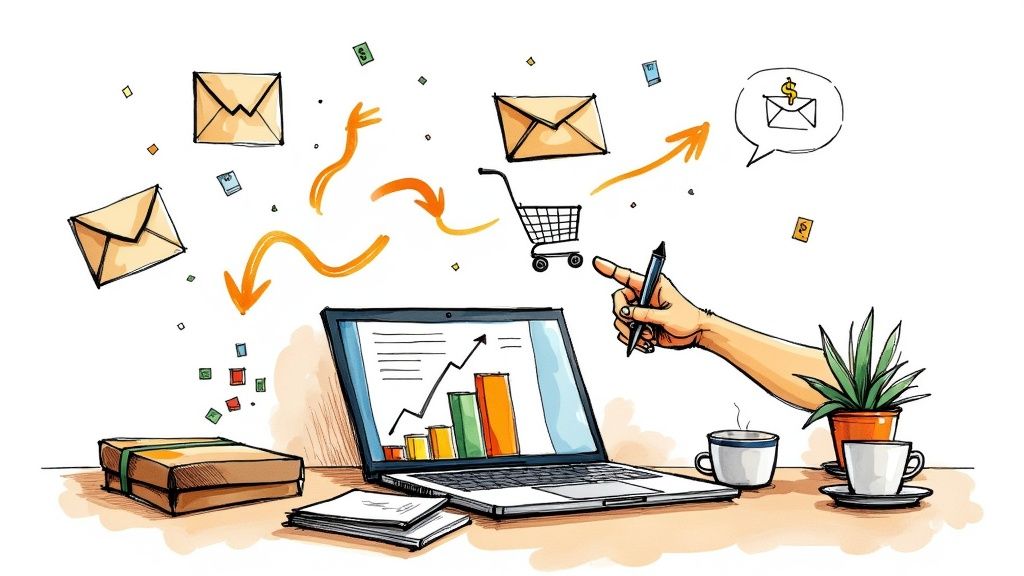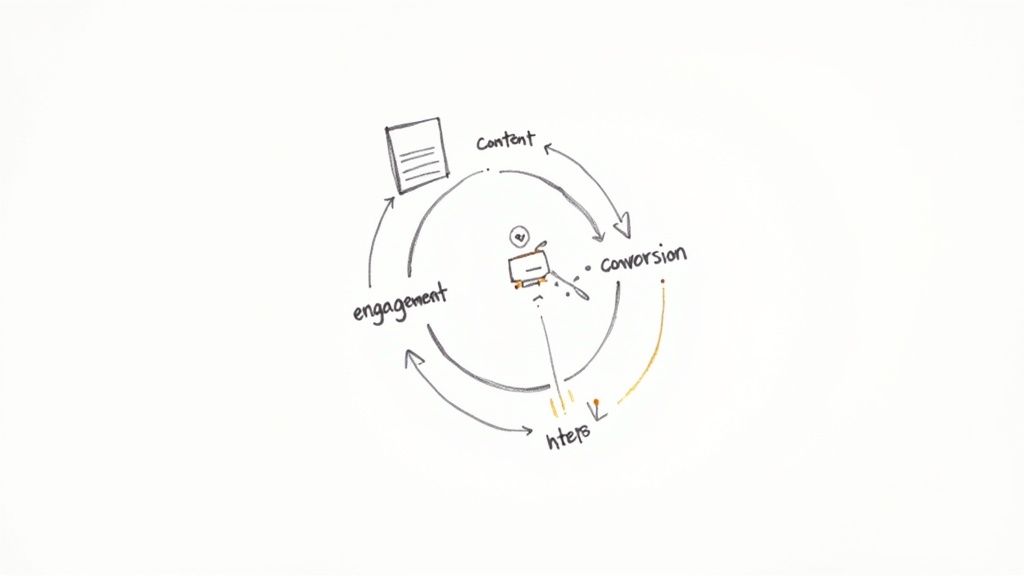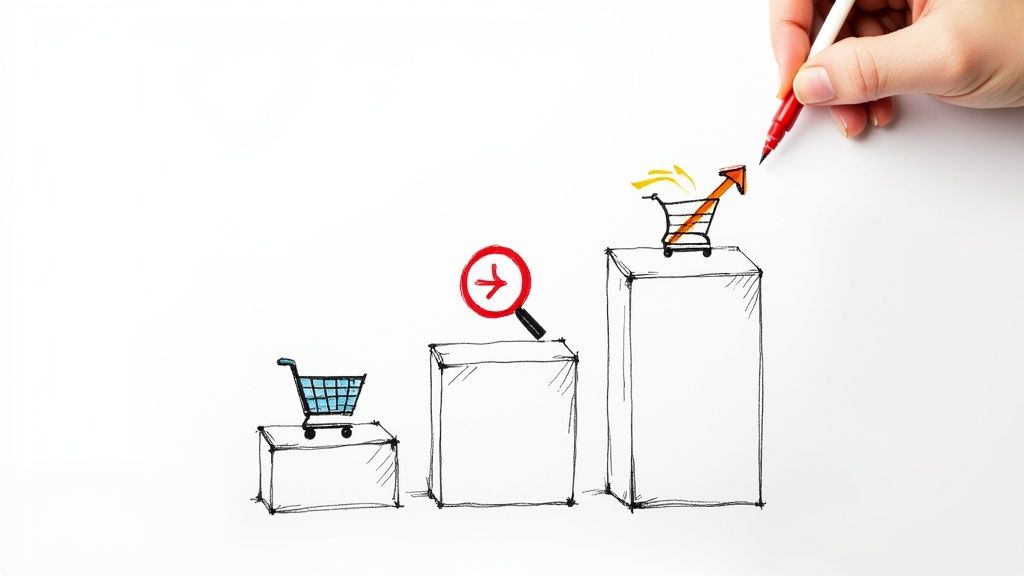Ecommerce Content Marketing Examples to Boost Sales
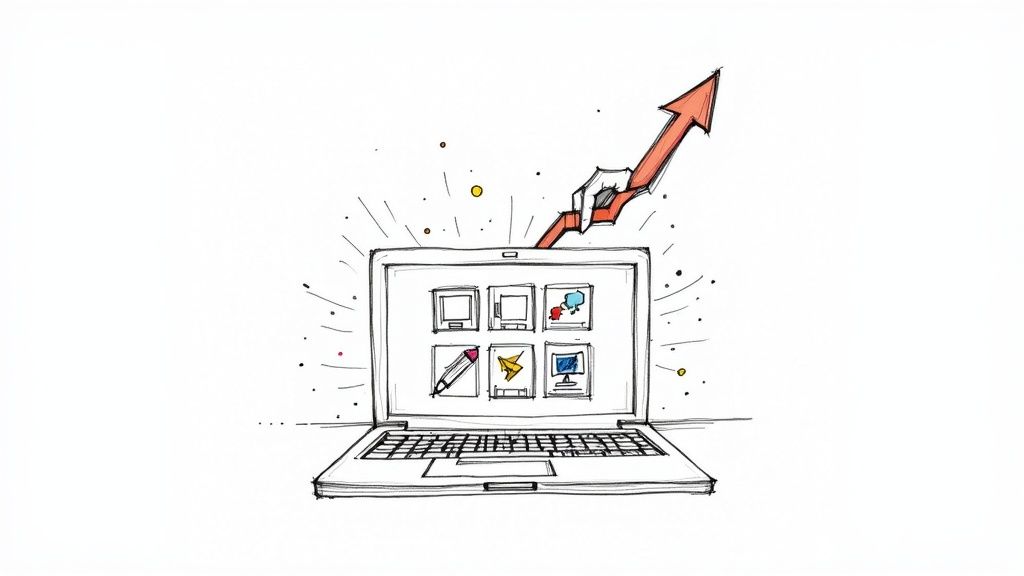
20 mins
5/27/2025
Joe Ervin
- ecommerce marketing
- content marketing
- ecommerce content marketing examples
- online sales
- content strategy
Make More Sales with Great Content
Want more sales? Content marketing helps people find your products. This list gives you eight ecommerce content marketing examples. Learn how to use user-generated content, blog posts, videos, and more to boost your sales. These examples show how simple content marketing can be. See how skincare, clothing, and other ecommerce brands use content.
1. User-Generated Content (UGC) Campaigns
User-Generated Content (UGC) campaigns use content made by your customers. This includes reviews, photos, videos, and social media posts about your products. This strategy builds trust and gets people talking about your brand. It also saves you money on content creation. Think of it as free advertising from your biggest fans! This approach is a powerful ecommerce content marketing example because it leverages the authenticity and social proof that comes directly from customer experiences.

UGC comes in many forms. Customers might share photos and videos of your products in action. They might write glowing reviews. They might even start a hashtag campaign about your brand. All of this creates a buzz around your products and makes people want to buy them.
Think about GoPro. They use customer videos of extreme sports to show off their cameras. Glossier shares customer makeup photos to build a beauty community. Airbnb uses guest travel stories to make people feel good about booking stays. These are all excellent ecommerce content marketing examples using UGC.
Why Use UGC?
UGC builds trust. People believe other customers more than they believe brands. UGC also costs less than making your own content. Plus, it gets your customers involved and makes them feel like part of your brand family. This can lead to more sales and loyal customers.
Features of UGC Campaigns:
- Real-world content: See how customers actually use your products.
- Reviews and testimonials: Share what people say about your brand.
- Hashtag campaigns: Get people talking about your products on social media.
- Contests and giveaways: Encourage customers to create and share content.
- Social media integration: Spread UGC far and wide.
Pros of UGC:
- Builds trust: Real people, real stories.
- Saves money: Customers create content for you.
- Boosts engagement: Customers feel connected to your brand.
- Shows different views: See your products in new ways.
- Helps SEO: Fresh content makes search engines happy.
Cons of UGC:
- Less control: You don't write every post.
- Needs management: You need to watch and respond to comments.
- Risk of bad press: Not all feedback is good.
- Takes time: Finding and sharing good UGC takes effort.
- May need rewards: Sometimes you need to give prizes to get UGC.
Tips for Success:
- Make clear rules: Simple hashtag contests work best.
- Show off UGC: Put customer content on your product pages.
- Talk to customers: Respond to comments and posts.
- Use UGC in emails and ads: Share the love everywhere.
- Check content: Make sure everything looks good and reflects your brand.
When to Use UGC:
Use UGC when you want to build a strong community. Use it to show off your products in action. Use it to save money on content creation. If you sell clothes, skincare, or anything else people use daily, UGC is a great way to connect with your customers.
Brands like GoPro, Glossier, Starbucks, and Coca-Cola have used UGC with great success. They show that user-generated content is a powerful tool for any ecommerce business. By making your customers part of your story, you create a powerful marketing engine that drives sales and builds loyalty.
2. Educational Blog Content and SEO-Driven Articles
Want more people to visit your online store? Educational blog content and SEO articles can help. This type of content teaches customers about your products, industry trends, and solutions to their problems. It also uses specific keywords to help your website show up higher in search engine results like Google. This brings free, organic traffic to your store.
Think of it like this: If you sell skincare products, you could write articles about different skin types, how to build a skincare routine, or the benefits of certain ingredients. When people search for these topics online, your articles might appear, leading them to your website.
This strategy is powerful because it attracts customers who are actively searching for information. They are more likely to become buyers because they’re already interested in what you offer. Learn more about Educational Blog Content and SEO-Driven Articles
Here's a breakdown of what makes educational blog content effective:
- How-to guides and tutorials: Show customers how to use your products or solve related problems. For example, a clothing store could create a guide on how to style a particular dress for different occasions.
- Industry trend analysis: Share insights about upcoming trends in your industry. A skincare brand might write about new ingredients or popular treatments.
- Problem-solving content: Address common customer pain points. If you sell running shoes, you might create content about how to choose the right shoe for different foot types or prevent common running injuries.
- Product comparisons and buying guides: Help customers choose the best product for their needs. This works well for electronics or appliances.
- SEO optimization: Use specific keywords that people search for to help your content rank higher in search results.
Examples of Success:
- Home Depot: Their DIY project guides help people complete home improvement projects, often leading them to purchase tools and materials from Home Depot.
- HubSpot: They offer lots of free marketing advice on their blog, which helps them attract potential customers for their marketing software.
- Patagonia: Their content about environmental issues and outdoor activities connects with their target audience and strengthens their brand image.
Benefits:
- Long-term traffic growth: SEO-driven content continues to attract visitors over time.
- Brand authority: Helpful content positions you as an expert in your field.
- Customer education: Guides customers through the buying process.
- Cost-effective: Organic traffic is essentially free advertising.
- Email subscribers: Offer valuable content in exchange for email addresses to build your marketing list.
Drawbacks:
- Consistent effort: You need to create and publish content regularly.
- Time investment: SEO takes time to show results.
- Ongoing optimization: Content needs updates to stay relevant.
- Expertise required: You need to know your subject well.
- Not immediate sales: Content marketing focuses on building relationships, not pushing immediate purchases.
Actionable Tips for You:
- Focus on long-tail keywords: Use specific phrases people search for when they’re ready to buy. For example, instead of "shoes," target "best running shoes for flat feet."
- Include clear calls-to-action: Tell readers what you want them to do next, like visiting a product page or signing up for your email list.
- Update content: Keep your content fresh and accurate to maintain search rankings.
- Use internal linking: Connect related articles on your blog to guide users to relevant products.
- Create content clusters: Group articles around central themes to build authority and improve SEO.
Educational blog content and SEO articles are a valuable strategy for ecommerce businesses. It's a long-term investment that builds trust, attracts customers, and establishes your brand as a leader in your industry. This approach is perfect for ecommerce brand owners, skincare brands, and clothing brands alike. It's a smart way to grow your business online.
3. Video Product Demonstrations and Tutorials
Video is a powerful tool for ecommerce content marketing. Showing your products in action helps customers understand their value. Tutorials, unboxings, and demos give shoppers the information they need before they buy. This makes video a great example of effective ecommerce content marketing.
Video product demonstrations and tutorials work by engaging multiple senses. Instead of just reading about a product, customers can see and hear it. This creates a stronger connection and a better understanding of how the product works and its benefits. Think of it like a test drive before buying a car.
What Makes a Good Product Video?
A successful product video includes several key features:
- Unboxing and First Impressions: Capture the initial excitement of receiving the product. Show the packaging and highlight the product's presentation.
- Step-by-Step Tutorials: Guide viewers through using the product. Clearly show each step and explain any important details.
- Before-and-After Transformations: For products with visible results, showcase the transformation. This provides compelling visual proof of the product's effectiveness. Skincare and cleaning products benefit greatly from this approach.
- Expert Demonstrations: Partner with experts or influencers to lend credibility and provide professional tips.
- Customer Testimonials: Feature real customers sharing their positive experiences. This builds trust and social proof.
Benefits of Using Video:
- Higher Engagement: Videos grab attention better than text. People are more likely to watch a short video than read a long product description.
- Fewer Returns: Clear demonstrations set accurate expectations. This reduces returns caused by misunderstandings about the product.
- Better Conversions: Seeing a product in action convinces shoppers to buy.
- Easy Sharing: Videos are easily shareable across social media and other platforms, expanding your reach.
- Stronger Connections: Videos build emotional connections with customers, fostering brand loyalty.
Challenges of Video Production:
- Cost and Time: Creating high-quality videos can be expensive and time-consuming.
- Technical Skills: You'll need video editing skills and equipment.
- Platform Optimization: Different platforms (YouTube, Instagram, Facebook) require different video formats.
- Shorter Shelf Life: Trendy videos can become outdated quickly compared to evergreen written content.
- Talent: You might need to hire professional presenters or actors.
Examples of Success:
- Sephora: Their makeup tutorials demonstrate how to use their products to achieve specific looks. This makes it easy for customers to visualize using the products themselves.
- Dyson: Their product demonstration videos highlight the innovative technology in their vacuums. They show the power and efficiency of their products in clear, concise ways.
- Blue Apron: Cooking instruction videos guide customers through preparing their meal kits. This makes the cooking process simple and enjoyable, adding value to the product.
Tips for Effective Videos:
- Keep it Short: Focus on key benefits. People have short attention spans, so get to the point quickly.
- Add Captions: Captions make your videos accessible to a wider audience, including those who watch without sound.
- Optimize Thumbnails and Titles: Eye-catching thumbnails and clear titles encourage clicks.
- Create a Series: Build anticipation and keep viewers engaged by creating a series of videos around a specific theme or product line.
- Embed Videos on Product Pages: Place videos directly on your product pages to boost conversions.
When to Use Video:
Video is especially useful for products that require demonstration or explanation. Clothing brands can show how garments fit and move. Skincare brands can demonstrate application techniques and highlight results. Any product with complex features or usage instructions benefits from video demonstration.
Video demonstrations and tutorials are a valuable asset for any ecommerce content marketing strategy. By showcasing your products in action, you can educate customers, build trust, and drive sales. This makes video a crucial part of your ecommerce marketing toolkit. While there are challenges to overcome, the benefits of increased engagement, reduced returns, and higher conversion rates make the investment worthwhile.
4. Interactive Content and Tools
Interactive content makes shopping fun. Think quizzes, calculators, and games. These tools help customers find the right products. They also give you useful data for personalized marketing. This engagement boosts your brand and sales. That's why it deserves a spot on this list of top ecommerce content marketing examples.

Imagine a shopper wants a new face cream. Instead of scrolling through endless options, they take a quick quiz. The quiz asks about their skin type and concerns. Based on their answers, the quiz suggests specific creams. This makes shopping easier and more personal. The shopper is happy, and you learn more about their needs.
Here are some ways to use interactive content:
- Product Quizzes: Help shoppers find the perfect product. A skincare brand might have a "Find Your Perfect Cleanser" quiz. A clothing brand might have a "Find Your Style" quiz.
- Cost Calculators: Show shoppers how much they can save. This works well for products with long-term value, like solar panels or energy-efficient appliances.
- Virtual Try-On: Let shoppers "try on" products virtually. Eyeglass companies like Warby Parker use this for glasses. Makeup brands use this for lipstick.
- Interactive Guides: Help shoppers make complex decisions. A furniture store might offer a guide to choosing the right sofa.
Pros:
- Keeps shoppers engaged: Interactive content holds attention longer than plain text.
- Gathers data: Learn what shoppers want directly from them. Use this data to tailor your marketing.
- Makes decisions easier: Quizzes and guides help shoppers feel confident in their choices.
- Builds brand loyalty: Creates fun and memorable experiences.
- Finds qualified leads: Shoppers who use interactive tools are more likely to buy.
Cons:
- Needs tech skills: Building these tools requires developers and can be costly.
- Ongoing updates: You need to update content to keep it fresh and relevant.
- Tech problems: Glitches can frustrate shoppers.
- Tracking results: Setting up analytics can be tricky.
Examples:
- Warby Parker: Offers a virtual try-on tool for eyeglasses. (www.warbyparker.com)
- IKEA: Has an AR app to see how furniture looks in your home.
- Stitch Fix: Uses a style quiz to recommend clothing.
Tips for Success:
- Start simple: Begin with a basic quiz. Don't jump into complex tools right away.
- Mobile-friendly: Make sure everything works well on phones and tablets.
- Automated follow-up: Send emails based on quiz results. For example, send a discount code for a recommended product.
- Test and improve: Try different formats. See what works best.
- Connect with CRM: Integrate your interactive tools with your customer relationship management (CRM) system. This helps your sales team follow up with leads.
When and Why to Use Interactive Content:
Use this approach when you want to:
- Boost engagement: Make your website more interesting.
- Learn about your customers: Gather valuable data for personalized marketing.
- Simplify complex purchases: Help shoppers navigate lots of options.
- Create a memorable brand: Stand out from the competition.
Interactive content is a powerful tool for ecommerce. It benefits both you and your customers. By providing engaging experiences, you can boost sales and build stronger relationships with your shoppers.
5. Influencer Collaborations and Partnerships
Influencer marketing is a powerful ecommerce content marketing example. It involves working with popular people online to promote your products. These people, called influencers, have a loyal following who trust their opinions. This trust makes influencer marketing very effective. Think of it as word-of-mouth marketing, but supercharged. This strategy deserves a spot on this list because it offers a direct line to engaged shoppers, boosting both brand awareness and sales.
Here’s how it works: You partner with an influencer who aligns with your brand and target audience. They create content featuring your products. This could be a review, a tutorial, or simply showcasing your product in their everyday life. Their followers see this content and, ideally, become interested in your products.
Influencer marketing offers several specific features:
- Sponsored Content: Influencers create posts featuring your products, often with a clear disclosure that it's sponsored.
- Product Placements: Your products appear naturally within the influencer's existing content.
- Collaborative Product Development: Work with influencers to create new products or improve existing ones. This leverages their expertise and connection with their audience.
- Influencer Takeovers: Let an influencer run your social media for a set time. This introduces your brand to a new audience.
- Brand Ambassadors: Build long-term relationships with influencers who regularly represent your brand.
- Micro-Influencer Campaigns: Partner with influencers who have smaller, highly engaged audiences within a specific niche.
Pros:
- Reach: Influencers give you access to their large and engaged audience, exposing your brand to potential customers you might not reach otherwise.
- Trust: People trust influencers they follow. Recommendations feel genuine and boost social proof, making customers more likely to buy.
- Brand Awareness: Quickly increase brand visibility and reach new customers.
- Cost-Effective: Often more affordable than traditional advertising.
- Professional Content: Influencers are skilled content creators, providing high-quality photos and videos.
Cons:
- Authenticity Concerns: If partnerships feel forced or inauthentic, audiences can become skeptical.
- Control: You have less control over the influencer's message compared to your own ads.
- Risk of Controversy: An influencer's negative actions can reflect poorly on your brand.
- Measuring ROI: Tracking the direct sales impact of influencer marketing can be tricky.
- FTC Compliance: Sponsored content must follow specific guidelines. Disclose partnerships clearly.
Examples of Success:
- Daniel Wellington: Built their brand through collaborations with numerous micro-influencers showcasing their watches.
- Fashion Nova: Uses celebrity and influencer partnerships to drive sales and trends.
- Gymshark: Works with fitness influencers to reach a dedicated audience of fitness enthusiasts.
Tips for Success:
- Choose Wisely: Find influencers whose values match your brand.
- Engagement over Followers: Prioritize engagement rates (likes, comments, shares) over sheer follower count. A smaller, highly engaged audience is often better than a large, inactive one.
- Creative Freedom: Allow influencers some creative control. Their authentic voice resonates best with their audience. Provide clear guidelines to ensure your brand message remains consistent.
- Track Results: Use unique discount codes or links to measure the success of each campaign. This helps you understand what works and what doesn't.
- Build Relationships: Focus on long-term partnerships rather than one-off posts. This fosters trust and creates more authentic content.
Influencer collaborations are a valuable tool for any ecommerce brand. By carefully selecting influencers and crafting authentic partnerships, you can reach new customers, build trust, and drive sales. Used strategically, influencer marketing is a core component of effective ecommerce content marketing.
6. Email Newsletter Content Series
Email newsletters are a strong way to connect with your customers. They help you build relationships and boost sales. They are a key part of ecommerce content marketing examples. Think of them as friendly chats that remind shoppers about your brand.
Email newsletter content series aren’t just one-off emails. They’re planned sets of emails sent over time. These emails combine helpful information with smart product ads. This approach helps grow repeat purchases and brand loyalty. You speak to your customer directly, building a bond that keeps them coming back.
Here’s how it works. You plan a series of emails. Each email has a goal, like teaching something new or showing off a cool product. You send these emails regularly, like weekly or monthly. This keeps your brand top-of-mind and encourages customers to buy again. Think of it like giving your shoppers VIP access to your store.
Features of a Winning Email Newsletter Series:
- Lessons and courses: Teach customers about your products or industry. For a skincare brand, this could be a series on different skin types. A clothing brand could share styling tips.
- Product spotlights: Show off your best products. Highlight new arrivals or special features.
- Seasonal guides: Help shoppers find the perfect gifts or items for each season. Think holiday gift guides or summer outfit ideas.
- Exclusive deals: Give subscribers special offers and early access to sales. This makes them feel valued.
- Success stories: Share how other customers use and enjoy your products. This builds trust and inspires new purchases.
Examples in Action:
- Morning Brew sends daily business news. They subtly weave in product ads.
- Birchbox shares beauty tips and product picks. This helps shoppers discover new favorites.
- Patagonia sends emails about the environment. They also show off their latest gear.
Pros of Email Newsletter Series:
- Direct connection: You talk directly to your customers.
- High return: Email marketing is cost-effective and can bring in lots of sales.
- Personal touch: You can tailor emails to different groups of shoppers.
- Repeat buyers: Email reminds shoppers to come back for more.
- Strong relationships: Regular emails build loyalty.
Cons of Email Newsletter Series:
- Time commitment: You need to create new content regularly.
- Unsubscribes: People might leave your list if the content isn’t good.
- Spam filters: Your emails might not reach everyone's inbox.
- Personalization takes time: Creating targeted emails takes effort.
- List cleanup: You need to remove inactive subscribers regularly.
Tips for Success:
- Group your shoppers: Divide your list based on what they've bought and what they like.
- Stay consistent: Send emails on a regular schedule. Keep the look and feel of your emails similar.
- Test your emails: Try different subject lines and content. See what works best.
- Clear calls to action: Tell shoppers what you want them to do (like visit your website). Don’t overdo the selling.
- Track your results: Watch how people react to your emails. Change your content based on what you learn.
Why Use Email Newsletter Content Series?
Email is a direct line to your customers. It’s a powerful way to build relationships and increase sales. It’s also a cost-effective way to promote your products and share valuable information. Learn more about Email Newsletter Content Series.
For ecommerce brands, especially those selling skincare or clothing, this is key. These industries thrive on customer relationships. Sharing skincare tips or styling advice creates value and builds trust. This makes people more likely to buy from you again and again.
Think about how many emails you get every day. The ones that stand out offer something useful or interesting. Your email newsletter content series should do the same. Give your shoppers a reason to open your emails and engage with your brand. This will turn them from one-time buyers into loyal fans.
7. Social Media Storytelling and Behind-the-Scenes Content
Show your customers who you are! Social media storytelling lets you connect with shoppers in a new way. Give them a peek behind the curtain. Show them what makes your brand special. Tell the stories of your company, your products, and your people. Build trust and make your brand feel real. This kind of content helps you stand out in a crowded market.

This approach goes beyond simple product posts. It's about sharing the human side of your business. Think about showing how your products are made. Introduce your team members. Share your company's values. This builds strong bonds with your customers. They'll feel more connected to your brand.
Think about a skincare brand. They could show the careful process of creating their new serum. They could introduce the scientist who developed the formula. A clothing brand might share a day in the life of their designer. They could show the ethical factory where their clothes are made. This creates a deeper connection with customers who value transparency and ethical practices.
Here are some ways to use behind-the-scenes content:
- Show product creation: Show how your products are made, from start to finish.
- Share founder and employee stories: Put faces to the names. Tell the stories of the people behind your brand.
- Show company culture: What are your values? What's it like to work at your company?
- Cover events live: Share real-time updates from product launches and other events.
- Show products in use: Show your products in action, in everyday life.
This approach offers many benefits. It builds trust and makes your brand seem more real. It helps you stand out from the crowd. It gets people talking about your brand. It creates a community around your products.
But there are also some challenges. Creating good content takes time and effort. You need to post regularly. It might not lead to sales right away. You also need to be careful about what you share. You don't want to share too much or the wrong things. Learn more about Social Media Storytelling and Behind-the-Scenes Content
Look at brands like Ben & Jerry's, Innocent Drinks, and Everlane. Ben & Jerry's shares their strong beliefs. Innocent Drinks uses a fun and friendly voice. Everlane shows how their clothes are made. These brands succeed with social media storytelling.
Here are some tips for success:
- Use the same brand voice everywhere: Be consistent across all platforms.
- Keep it real: Share real moments, not just perfect pictures.
- Use Instagram Stories and TikTok: These platforms are great for real-time content.
- Get your employees involved: Encourage them to share your brand story.
- Mix it up: Share fun and interesting content along with product promotions.
Why is this type of content so important for ecommerce? Because it builds relationships. Online shopping can feel impersonal. Behind-the-scenes content brings the human touch back to your brand. It creates a connection. This connection leads to loyalty. Loyal customers are the best customers! They buy more. They tell their friends about your brand. They become part of your community.
Social media storytelling is powerful. Use it to connect with your customers on a deeper level. Show them who you are, what you believe in, and what makes your brand special.
8. Content-Driven Product Launch Campaigns
Want a big product launch? Content marketing can help. A content-driven product launch campaign uses stories and information to build excitement before your product goes on sale. This means making interesting content like videos, articles, and social media posts. This approach helps build a loyal audience eager to buy your product on launch day.
Think of it like a movie premiere. Movie studios don't just release a film. They build hype with trailers, interviews, and behind-the-scenes looks. Content-driven product launches do the same for your products.
How it Works:
This method focuses on creating a buzz. You give your audience sneak peeks and valuable information about your product before it’s available. This generates demand and gets people talking.
Features of a Strong Campaign:
- Teasers: Short, exciting glimpses of the product before launch. Think short videos or intriguing images.
- Product Story: Share the story behind your product's development. Why did you create it? What problem does it solve?
- Early Bird Access: Let special customers or influencers try the product early and share their thoughts.
- Multi-Channel Promotion: Share your content across all platforms—website, social media, email, etc.
- Post-Launch Support: Help new customers learn how to use your product with tutorials and FAQs.
Pros:
- Builds Excitement: Get people talking about your product before it's even out.
- Creates a Content Library: Reuse your content later for marketing.
- Big Launch Impact: A coordinated message makes a bigger splash.
- Educates Customers: Help customers understand your product's value.
- Earns Media Attention: A great story can get your product free press.
Cons:
- Takes Lots of Planning: You need a solid plan and resources.
- Risk of Overhyping: Don't promise too much.
- Timeline Management: Keeping everything on track can be tough.
- Upfront Costs: Content creation takes time and money.
- Campaign Fatigue: Too much content can bore people.
Examples:
- Apple: Apple masters the art of the teaser with sleek videos and big keynote events for new iPhones.
- Tesla: Tesla used a unique reveal event and ongoing content to generate buzz for the Cybertruck.
- Supreme: Supreme creates hype and scarcity around its limited product "drops" using social media.
Tips for Success:
- Start Early: Begin creating content while the product is still in development.
- Content Calendar: Plan your content around key launch milestones.
- Reward Loyal Customers: Give early access or exclusive previews to your best customers.
- Document the Journey: Share the story of your product's creation.
- Post-Launch Plan: Keep the conversation going after launch with new content.
The following infographic illustrates the key phases of a content-driven product launch, highlighting the timeline from pre-announcement teasing to launch day activation.
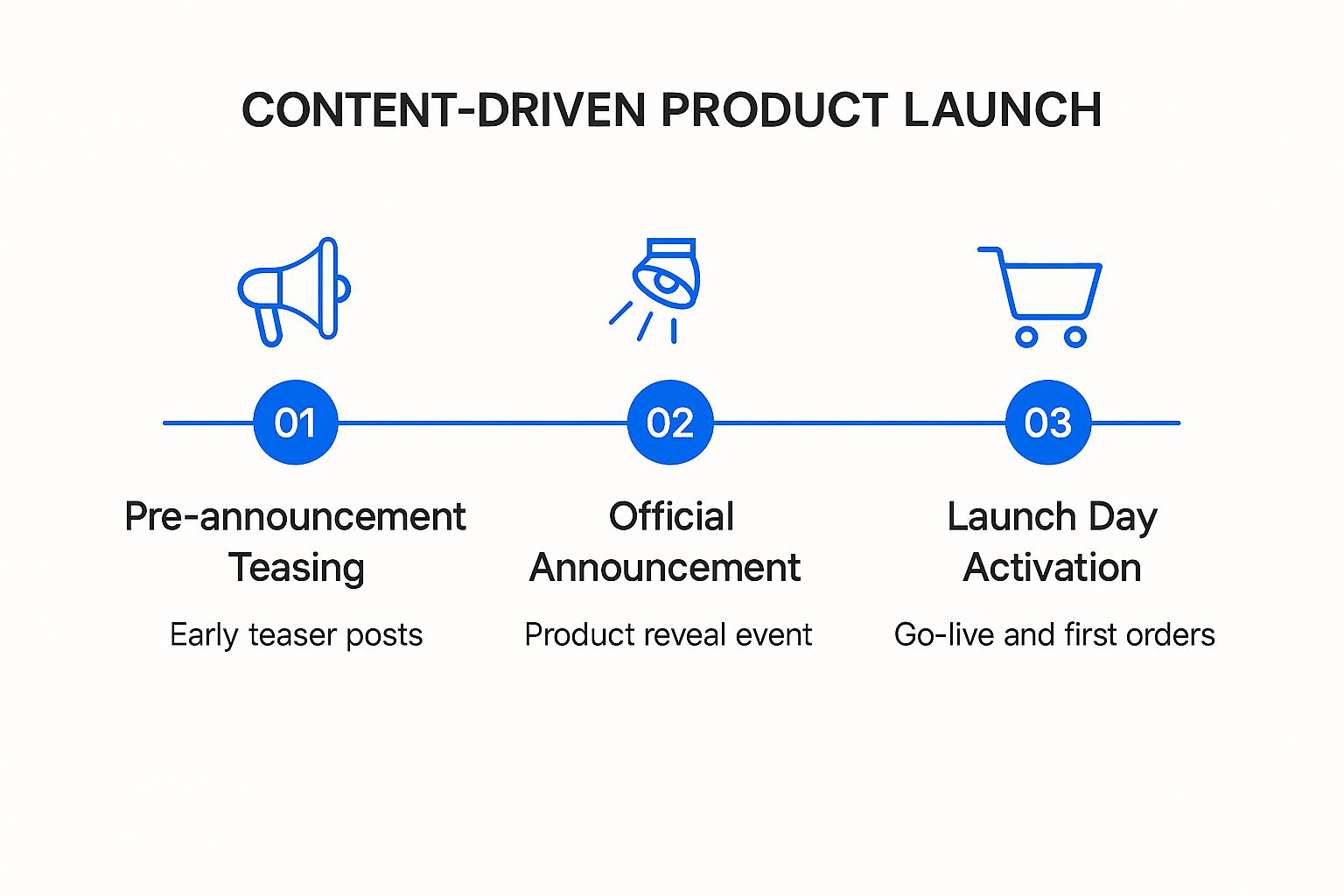
This timeline shows the importance of building momentum. Starting with early teasers, the campaign moves to a big reveal, and finally ends with the product launch and first sales.
Why This Works for Ecommerce:
Content-driven launches are perfect for ecommerce because they build direct relationships with customers. By sharing valuable content, you build trust and excitement. This leads to higher sales and a loyal following. Whether you sell skincare, clothing, or anything else, this approach helps you stand out in a crowded market. By educating your audience and creating a buzz, you can turn product launches into big events.
8 Ecommerce Content Marketing Examples Comparison
| Content Strategy | Implementation Complexity 🔄 | Resource Requirements ⚡ | Expected Outcomes 📊 | Ideal Use Cases 💡 | Key Advantages ⭐ |
|---|---|---|---|---|---|
| User-Generated Content (UGC) Campaigns | Medium – requires community management and moderation | Low to medium – relies on customer content and social sharing | Increased engagement and conversion; authentic trust | Brands seeking authentic social proof and engagement | Cost-effective content; diverse perspectives |
| Educational Blog Content and SEO | Medium – consistent content creation and SEO expertise needed | Medium – requires skilled writers and SEO tools | Long-term organic traffic growth, brand authority | Brands focusing on education and SEO-driven sales | Builds expertise; supports buying journey |
| Video Product Demonstrations & Tutorials | High – video production and editing skills required | High – equipment, editing software, professional talent | Higher engagement, reduced returns, improved conversions | Brands that benefit from visual product explanations | Strong emotional connections; shareability |
| Interactive Content and Tools | Very High – technical development, maintenance, analytics setup | High – skilled developers and data systems | High engagement, data collection, qualified leads | Complex products needing personalized recommendations | Collects zero-party data; reduces decision fatigue |
| Influencer Collaborations & Partnerships | Medium – coordination and relationship management | Medium – influencer fees and campaign management | Rapid brand awareness and authentic endorsements | Brands leveraging influencer audiences | Access to engaged audiences; professional content |
| Email Newsletter Content Series | Medium – content planning and segmentation required | Low to medium – email platforms and content creation | High ROI, repeat purchases, customer retention | Brands focusing on relationship building and retention | Direct customer communication; personalization |
| Social Media Storytelling & BTS Content | Medium – ongoing authentic content creation | Low to medium – minimal production, requires creativity | Builds brand personality and emotional connections | Brands building trust and engaging social communities | Humanizes brand; increases engagement |
| Content-Driven Product Launch Campaigns | High – extensive planning and multi-channel coordination | High – cross-functional teams and multi-format content | Builds anticipation, demand, and media coverage | New product launches requiring comprehensive impact | Maximizes launch impact; sustained engagement |
Ready to Grow Your Sales?
This article showed you great ecommerce content marketing examples. You saw how user-generated content, blog posts, videos, and more can boost your sales. Interactive tools, influencer partnerships, email series, and social media stories also help. Use these ideas to connect with shoppers and build your brand.
These examples work for all kinds of ecommerce brands, from skincare to clothing. Strong content shows customers why they need your products. It builds trust and turns shoppers into loyal fans.
Mastering these content strategies is key to online growth. Great content brings more traffic to your store. It helps you sell more and grow your business faster.
Trace can help you build a complete email and content system. We create campaigns and automations that get new customers and keep current ones coming back. Try Trace today. Grow your business.
